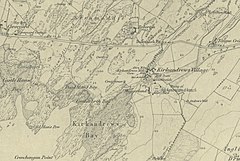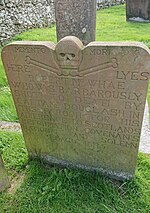Kirkandrews, Dumfries and Galloway
Kirkandrews, sometimes written as Kirkanders in older documents, is a coastal hamlet about 9 kilometres (6 mi) west-southwest of Kirkcudbright in Dumfries and Galloway, Scotland.
These include the ancient churchyard with some surviving stonework from its medieval church, a listed village hall that is used for religious services and private events, and a short distance along the coast there is a dun, built in the Iron Age and reused by Scandinavians, which was renovated in the early 20th century and has since been designated a scheduled monument.
[3] A similar account is given by W. J. Pennell in The Story of Knockbrex, which reports that the church was built on the site by monks from Iona Abbey, and was named for a 9th-century Irish saint called Andrew.
George Chalmers, in his account of Scottish history Caledonia, indicates that it was named for the St Andrew, the apostle and patron saint of Scotland.
[5] R. C. Reid, a fellow of the Society of Antiquaries of Scotland, argues that the original name of the church must have been lost because the prefix 'Kirk' is not one that would have been used at the time when Ionian monks were active in the area.
[6] A 1970 assessment by the Ordnance Survey's Archaeology Division also noted that it was probably rededicated to St Andrew in the 12th century, and that its earlier dedication is unknown.
[7] Local historian Daphne Brooke agrees with this assessment, and suggests that the choice of St Andrew, a fisherman, would have been in keeping with Kirkandrew's status as a port town.
There are signs of Iron Age habitation at Castle Haven, 700 metres (0.4 mi) along the coastline to the north west, in the form of a 1st-century BCE dun.
[26][27] The settlement around that time appears to have been in a very run-down condition: Daniel and Ayton, recounting their visit in the summer of 1813, described it as "the ne plus ultra of lowness and obscurity".
They explain that it had previously been a centre of smuggling but that customs officers had seized all the village's boats and broken up the racket, leaving the inhabitants with no means of making an income.
[34] Designed by the Arts and Crafts architect George Harry Higginbottom,[36] it is accessed through an elaborate timber lychgate, and made to resemble a small castle.
The church no longer remains as a complete building, but two burial enclosures in the middle of the yard appear to incorporate some of the fabric of its original walls.
[38] The Castle Haven dun, which was designated a scheduled monument in 1928,[41] is approached from Kirkandrews by a path which crosses the burn over a wooden bridge and follows the coast to the north-west.
During the excavations that preceded the modifications, artefacts including bronze spiral finger-rings and a blue glass paste bead, dated to the Iron Age, were discovered, alongside a brooch and fragments of mail that are suggestive of later reuse.




